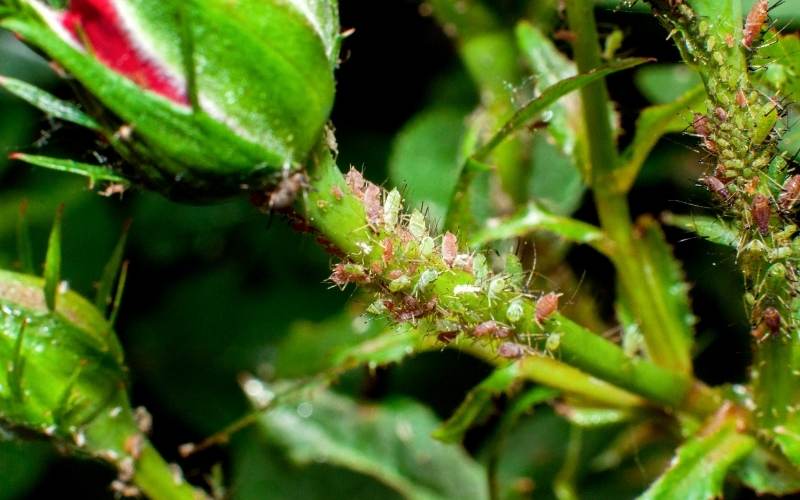
Aphids, also called blackflies or greenflies, are small insects of the Aphidoidea superfamily you need to eliminate naturally when they colonize your plants and suck their sap.
There are at least 5,000 species of aphids in the world. Aphids are one of the most common complaints for garden plants and even house plants worldwide.
They often go unnoticed for long because they are of different colors, but all very small. Aphids can cause health problems to plants, therefore you need to act promptly as soon as you see them.
Getting rid of aphids is fairly simple but at times laborious. There are many ways you can use to control or kill aphids naturally. You can get rid of them once they come or prevent them before hand. All methods l into 5 main categories:
Mainly to eliminate them:
Mainly yo prevent them by using aphid predators or growing plants for aphid control.
First of all, you will need to identify them, and know key facts about these tiny animals, then, we will go through all the natural methods you can use to get rid of aphids in detail and even find out the advantages and disadvantages of each method.
So, here are our best tips on Identifying and treating aphids on your garden vegetable plants.
What Do Aphids Look Like?
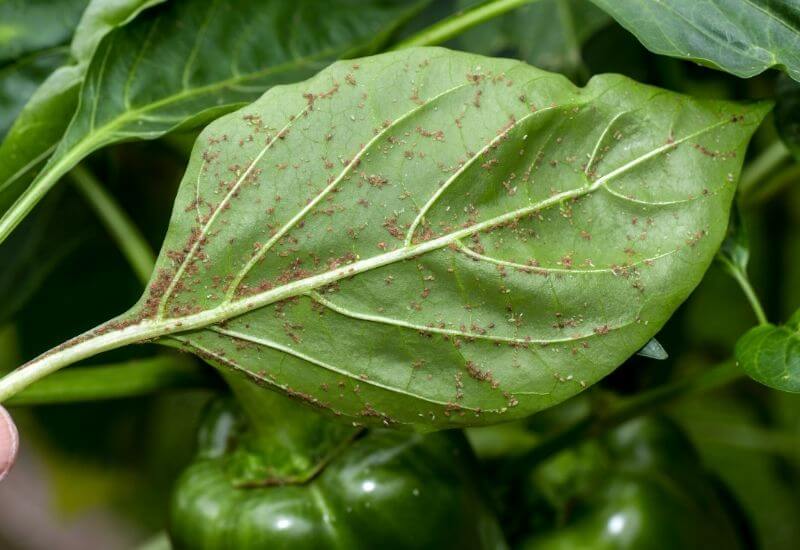
Aphids are a huge number of very small insects with traits in common. The size is between 2 to 4 millimeters (1/16 to 1/8 of an inch) and this is why we often fail to spot them. They have long and thin legs and a soft looking roughly oval shaped body. The exact shape can change according to the species, but it is always joint and oblong.
Basically, they do not have divided parts of the body, like ants, wasps and bees. If you look at them closely, they look a bit like plump grasshoppers.
They can be of different colors, yellow, white, red, green, brown, black, orange… Actually in the 5,000 species you can find all the colors of the rainbow and even woolly aphids. These are special because they are hairy, and they look like woolly fluff on your plants.
They live in groups (colonies) and reproduce very fast. A female can give birth to about 12 aphids every day laying eggs.
However. Some can give birth to a new aphid every 20 minutes!
This means that the colony can grow very fast… But… They do not even need to lay eggs! No, aphids can reproduce a-sexually.
They can eject a small fully shaped nymph from their back, and that is literally a clone of the aphid… They clone themselves!
What Do Aphids Eat?
Aphids suck the sap of plants from their proboscis, a long “mouth organ” with a piercing tip that they burrow under the epidermis (the “skin”) of leaves and young stems.
Sap is a solution of water and nutrients that plants transport up and down their body in tubes (like our veins) called phloem. It also exists in another tissue, xylem cells, but in any case, it is “under the skin” of the plant.
This of course means that the plant has less energy and food for itself.
Where Do Aphids Come from?
Aphids are native all continents, three species have even been identified in Antarctica! However, they are more common in temperate areas. But how do they actually get to your plants?
The answer is simple, aphids simply move from plant to plant. So, they come from a neighboring plant. Very often, they will suck the sap of plants till they become weak then leave.
This is simply because the weakened plant cannot sustain them any more and they prefer a fresh and strong one.
How Do Aphids Grow and Propagate?
During their life cycle, they shed their skin a few times before becoming adults. As soon as the egg hatches or the nymph is cloned, it starts sapping on the sap of the plant, using a long organ called proboscis to pierce the leaf or stem and find the sap it needs.
But there is a little complication… Aphids digest the sap and excrete honeydew, a sweet substance which comes out as liquid drops from their back…
Why is it a problem?
Because many insects love it and in particular ants…
And ants are very intelligent and organized and they literally treat aphids like cattle: they protect them, they keep them in “herds” and they collect the honeydew.
So ants have all interests in keeping the aphid population high.
What Damage Do Aphids Cause to Plants?
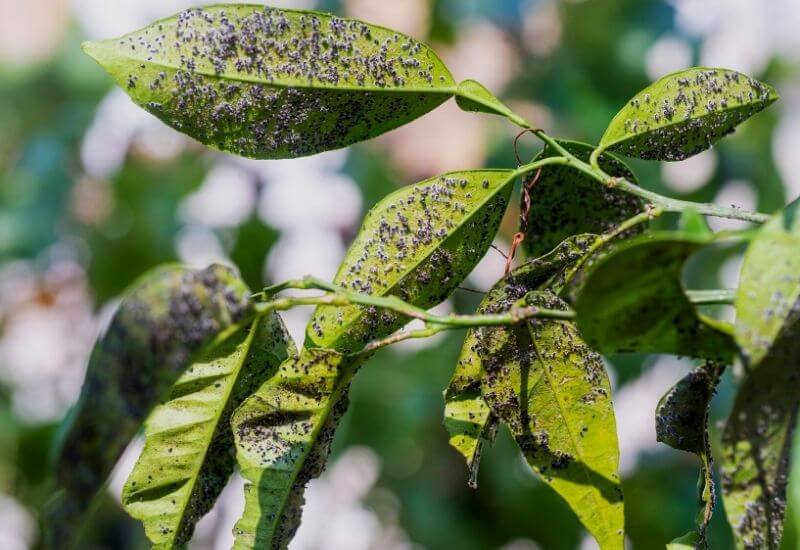
Aphids can cause serious damage on your plants but they are rarely lethal. Only young and already weak or sick plants will actually die because of aphids. An adult an healthy plant will usually withstand the infestation, but not without damage. In fact:
So, you have quite a few valid reasons to get rid of aphids, but fist of all, let’s see how you can identify them.
How to Find Out if You Have an Aphid Problem In Your Garden?
You need to identify aphid damage on plants before you take measures to get rid of them. To do this, you will need to:
Plants That Aphid Attack Frequently
Aphids don’t like all plants in the same way: they prefer some which have soft tissue and they can easily pierce it to feast on the sap beneath the surface. Unfortunately, this means that they will go for fast growing plants. And guess what? Most vegetables come from fast growing plants, like:
These are all irresistible to aphids. Then of course, there are many of the most popular garden plants, like:
In fact, all in all 25% of all plant species are susceptible to aphid infestations. And many are in our back garden.
Why You Should NOT Use Chemicals to Kill Aphids?
“Good,” you may think, “surely the garden center has some chemical product to kill aphids.” And it certainly will, but before you rush out…
And now you will see how easy and cheap it is to use natural remedies to get rid of aphids…
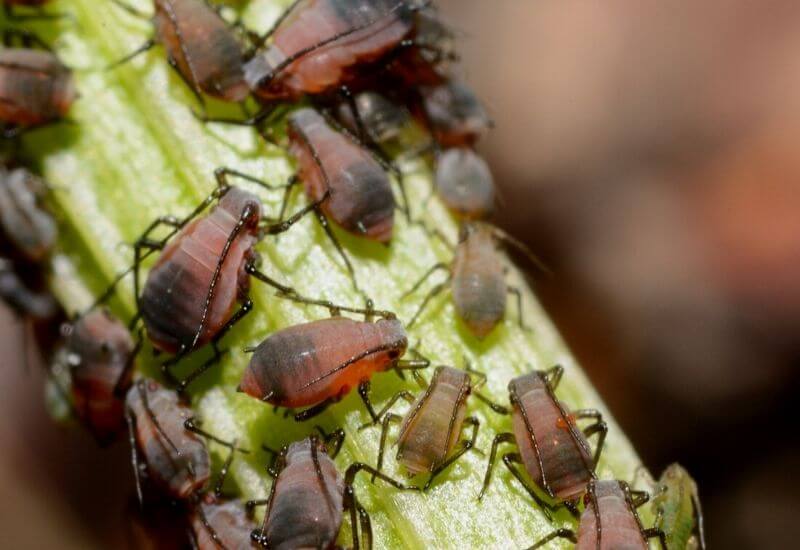
How To Get Rid Of Aphids Naturally Without Using Chemicals
We are now about to go through all the natural methods to get rid of aphids we have. But you will need to choose the best one for you.
And it will depend on the size of the infestation, its gravity, the size of the crop or garden, where it is and even what you already have in the cupboard, because many of these methods really need very simple ingredients.
If you already have an aphid problem, big or small, you will have to get rid of them. Heavier problems will require more drastic solutions. Still the key strategies are removing them by hand, using pressure to get them off the plant or one of the natural sprays you are going to see.
Some of these methods will also double up as prevention, as we will see in the next section.
Killing aphids naturally is cheap and effective methods to get rid of aphids, so you don’t get tempted to use chemicals. And, unlike with chemical products, these remedies can actually be fun – as you are going to find out!
Here the 8 natural aphid control options that are safe for your plants, the environment, and beneficial bugs in your garden:
1. Removing Aphids By Hand From Your Plants
Removing aphids by hand is self-explanatory. It is as simple as it says on the can. It could be an option, even if of course not the best one. However, it is really viable only if you have a very small infestation, which means that you spotted the aphids as soon as they came… In fact it has many drawbacks:
But still, we had to mention it.
2. Using Pressure To Get Rid Aphids Off The Plants
You you use pressurized wind or pressurized water to scatter the aphids away from your plants. This is a much better and even more humane method than picking them by hand, because you won’t kill them.
It may be overkill though with small problems… Having said this, it is a good method for public parks and vegetable gardens of a good size. It is fairly quick but noisy.
You can simply use:
This method too has some disadvantages:
Let’s dwell a second on this last point… You see, the aphids will be blown off the plants but they won’t go too far.
You will still need to use some natural repellants after this. And we are about to see them. But it is a viable “shock therapy” and “first approach” in grave cases.
3. Get Rid Of Aphids By Spraying With A Mild Solution Of Dish Soap And Water
Now you read “soap and water spray” you realize how simple and easy it an be to get rid of aphids from your garden – and cheap!
The method is simple and straightforward all you need to to do is spraying the leaves of the aphid infested plant with a mild solution of 5 tablespoons of soap per 1 gallon of water, but there is one condition to this method: For controlling aphids is use natural soap.
Unfortunately most soaps on the market are chemical products, and these are bad for your garden…
Here How make your Natural Liquid Soap Spray to kill aphids:
Adapt the quantities to your needs, but this simple method has some great advantages, including the fact that it is cheap and super safe.
However, it may not work on a large colony or a well established one.
It works by making the leaf or plant surface difficult to stick to. Aphids will then need to find another place to go.
But it will need repeated treatments, every 2 or 3 days for two weeks, and after it rains, as they may come back.
4. Make Your Own All-Natural Garlic Spray To Deter Aphids
Garlic water spray is arguably the best spray method for controlling aphids naturally. In fact it is so good that it’s the only method they use for the rose garden of Her Majesty the Queen at Buckingham Palace, and if it’s good for a monarch…
The principle is simple: aphids hate garlic. Most insects do, to be honest. And in fact this method will work with virtually all insect infestations. Which is another bonus. There are two ways of preparing this, and now we’ll see how.
Done! And the smell? It will go within 24 hours, and your roses will still smell of roses. We won’t smell it but aphids will and they will keep away.
This is also an excellent method to prevent aphid infestations.
In fact, I strongly advise it to all gardens at risk of any insect infestation. Start in spring and repeat it every two weeks and your (vegetable) garden will be big and aphid free.
5. Control Aphids Naturally And Organically Using Neem Oil
Neem oil is becoming the panacea of all organic gardeners and it works against aphids too. The thing with neem oil is that it is toxic to most animals (including us) but totally absorbable and metabolized by plants.
This means that neem oil is good against all insects, but also fungal infections and bacterial ones. This is why, if you don’t have a bottle of neem oil and you have a garden, just go and get one now… It also has a shelf life of many years…
Here how to prepare homemade sprays for fighting aphids
This method may be a bit drastic for aphids. It will work, and it will work well. But garlic water remains the most appropriate for general conditions.
The fact is the while neem oil is totally innocuous to plants, it is not to fungi and bacteria. And true, some of them are a problem for our plants, but others are absolutely necessary for their lives…
A bit like the “good bacteria” in our intestine…
So, do use it, but keep in mind that excessive use of neem oil may change the life balance within the soil. And there are lighter alternatives.
6. Spray Essential Oil On Plants For Keeping Aphids Away
Essential oils have a strong smell, and aphids and many insects just can’t bear the very aroma we like so much!
This is one of the most creative, but nonetheless effective, ways of keeping insects away from your plants. And the result is also pleasant and sweet smelling.
You just need to choose one or more of the oils they can’t stand, here are few essential oils best for controlling aphids:
A mix of these will be totally revolting for aphids.
This system too is quite good as prevention of aphids. You will want to use it regularly throughout the warm season to keep aphids and other insects at bay.
Of course, the drawback is that essential oils are expensive, much more than soap or garlic, even if you only use a few drops, and they may be difficult to find.
8. Growing Plants That Naturally Repel Aphids
The concept of growing plants that control the aphid population goes with the “useful bug” method we have just seen. They are both ways of re-establishing a healthy and balanced ecosystem.
You know that this is very core to all organic and natural farming, gardening and land management in general.
There are three types of plants you can grow to control the population of aphids, and the best way forward is to grow some of all these three types:
To make the best of these plants, you can scatter the first two types among those plants you know will attract aphids and then offer them a pleasant alternative a bit off your precious flower bed with the third type of plants.
How To Prevent Aphids From Coming
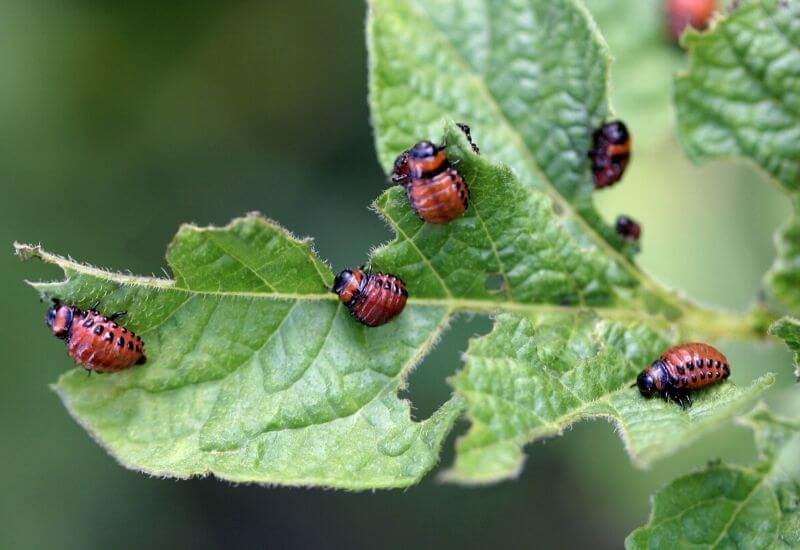
There is a whole science behind preventing aphids and other pests from being a problem to your garden. It includes some key points like:
Keeping a healthy ecosystem (and we will see how to do it with plants and bugs).
These are the general principles, not the methods, which we will see right now.
First of all note that some methods to get rid of aphids can also be adapted to prevent them. The cheapest, simplest and most common is garlic water spray, but also essential oil sprays may be used.
The trick is to start using them as soon as the warm season starts (mid spring) and repeat them every fortnight.
Even neem oil could work, but it is better avoided as prevention and more suitable and practical to eliminate aphids.
So, we are left with two more, but quite elaborate and advanced methods: introducing and encouraging “good bugs” (aphid predators) and growing plants that control the aphid population.
We will see them right now and trust me, they are very interesting and even intriguing methods.
Using Natural Aphid Predators To Control The Pests
The best method from many points of view is to “breed” natural aphid predators. This is by far the most advanced and “green” method, because it is based on re-establishing a natural and balanced ecosystem.
Ethically speaking, and within a mature ecological perspective, aphids are not useless…
They are part if the food chain, for example…
And guess which insect would disappear without aphids? The beautiful ladybird (ladybugs, or lady beetles).
So now you can literally buy ladybirds to control aphids. And the correct word is “control”… There will be a few aphids around, but not enough to even bother your plants.
Literally a few on a few stems here and there… That’s a natural balance…
Here are the most most well-known natural predators that will eat eat aphids:
So you can have a little “zoo” while you control the aphid population, and in the meantime give a helping hand to the environment and Mother Nature.
You can buy these insects or attract them (or both):
This is of course easer to do if you have a large garden. It’s hard to do it on a small terrace or if you just have a tiny back garden. But still…
The Best Method to Get Rid of Aphids
So, which one is the best method to get rid of aphids? It is up to you, of course, and it depends a lot on your garden and on the situation. But let me suggest that you use a combination of methods?
Growing plants that control aphids and welcoming “good bugs” should be standard whenever possible.
Then you can choose one or two light methods (soap or garlic, maybe) just as routine maintenance to prevent them from coming.
If then you are so unlucky (or something goes really off track in the ecosystem of your region), you may want to keep a more drastic method as a last resort.
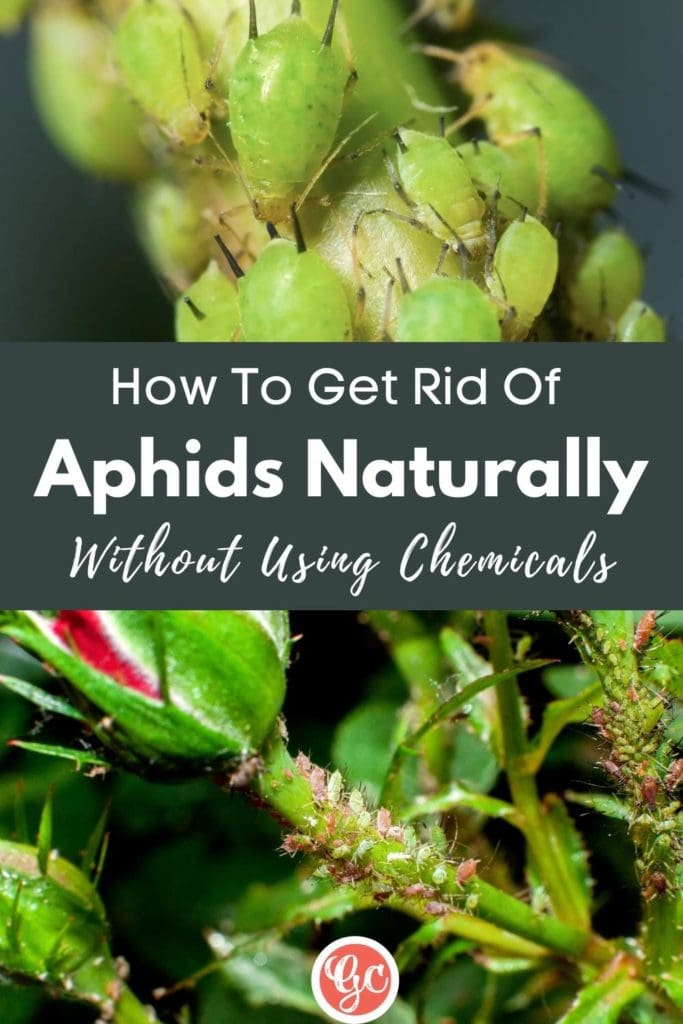

Written By
Amber Noyes
Amber Noyes was born and raised in a suburban California town, San Mateo. She holds a master’s degree in horticulture from the University of California as well as a BS in Biology from the University of San Francisco. With experience working on an organic farm, water conservation research, farmers’ markets, and plant nursery, she understands what makes plants thrive and how we can better understand the connection between microclimate and plant health. When she’s not on the land, Amber loves informing people of new ideas/things related to gardening, especially organic gardening, houseplants, and growing plants in a small space.
